How two Scottish farms plan to become more sustainable
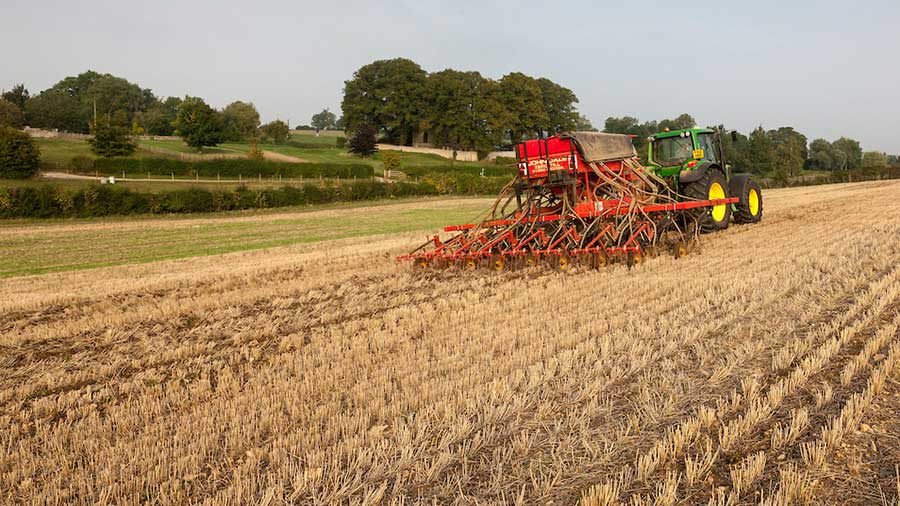 © Tim Scrivener
© Tim Scrivener Two rapidly growing Aberdeenshire farming businesses are looking to “close the loop” as they navigate their way to a sustainable future, while coping with the challenges that the next few years will bring.
Having developed short, medium and long-term goals with the help of the Linking Environment and Farming (Leaf)/Corteva Resilient and Ready programme, they are already making changes to the way that they farm.
See also: How a drill kit enabled farmer to adopt variable seeding
As both farms prepare for a less certain future after 2024, waste is being reduced, fewer inputs are being used, imported raw materials are being swapped for home-grown alternatives and new ideas are being tested.
HB Farms, Dumbreckt, Ellon
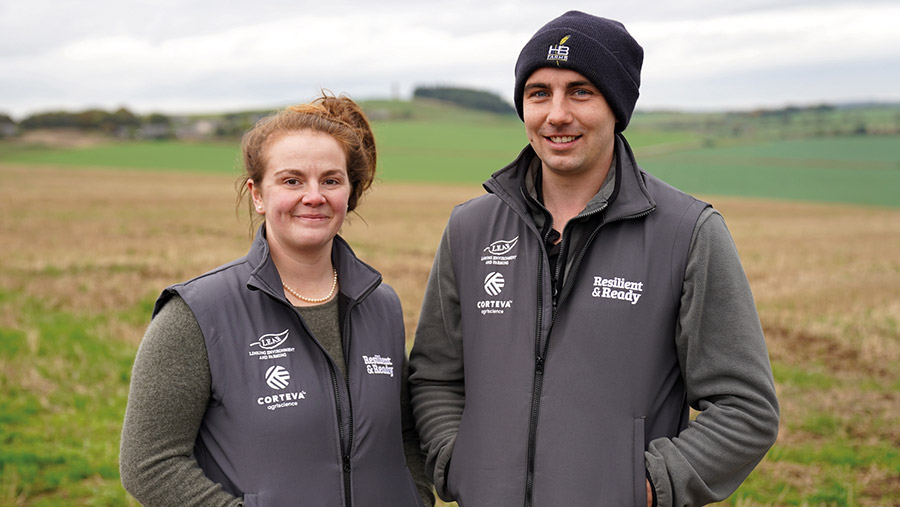
Harriet Ross and Ben Lowe © Louise Impey
For Harriet Ross – Farmers Weekly Young Farmer of the Year 2021 – and partner Ben Lowe, the past three years have seen them take on their first tenancy, start managing her parents’ arable farm and buy a local pig farm.
With so much to do, they have identified where they need to focus their energies and are working together to put that into practice.
HB Farms: Key actions
- Developing a more diverse, lower input system
- Building resilient soils
- Planning wildlife habitats for biodiversity
Short term
Their first step to becoming more sustainable is to develop a more diverse, lower-input system, with a focus on getting the basics right and being more efficient.
To this end, the rotation at Newseat of Dumbreckt is changing – with milling oats being replaced by winter barley, so that the grain can be used to feed the pigs and manures used within the rotation.
With reduced fuel and fertiliser use being priorities, grass grown for a local anaerobic digester plant is being kept as part of the system, so that soil structure improves and low-disturbance drilling techniques can be introduced – usually following the application of digestate.
Last year, they compared direct-drilling winter wheat straight into the grass with a plough/combi drill approach, which has seen a 0.5t/ha uplift in yield from direct-drilling.
Both fields were also put through a carbon footprinting tool, with very little difference seen in emissions, despite the lower fuel use.
The financial results were close, too, with the direct-drilled crop generating a better gross margin by £3/t.
“I expected to see a greater difference in the carbon footprint results with the lower diesel use,” says Ms Ross.
“We are repeating the trial this year, and have direct-drilled another field to see how it performs.”
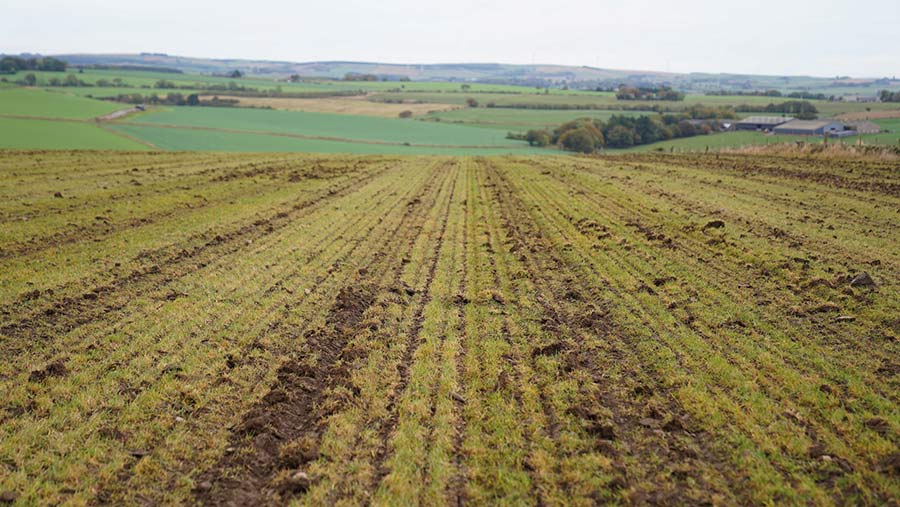
Winter wheat drilled into grass using Mzuri drill (photo courtesy of Harriet Ross and Ben Lowe)
Medium term
In the medium term, the farm is intent on building more resilient soils. Having been a dairy farm in the past, the topsoil is in very good condition and frequent farmyard manure applications have benefited soil fertility.
Mr Lowe, who trained as an agronomist, is keen to understand how the soil is cycling nutrients and if crops can make best use of them, as he drives down input costs.
He has also measured pH at three different depths, tweaking the use of lime to ensure that they get the maximum benefit.
Taking the pH up to 6.5 should give better nitrogen use efficiency.
Earthworm counts have started, and the direct-drilled land is already showing higher numbers (seven worms) than ploughed fields (one to two worms). That land is also travelling better and draining well after heavy rainfall.
A trial with a nitrification inhibitor product showed no yield response in wheat, despite helping to retain more nitrogen in the soil rather than losing it to leaching.
Long term
Providing diverse wildlife habitats across the farm is a long-term goal of HB Farms, as it looks to support biodiversity.
With the help of ecologist Tamsin Morris, they have mapped and monitored the farm to understand what is already present in such an open landscape and how it can be enhanced.
Ms Morris identified that open burns with grass cover provide the perfect habitat for water voles, which are in decline nationally, so they are looking into widening the grass strips rather than planting trees by burns.
With stubbles being left to support seed-eating bird populations, they are investigating how they can increase habitat connectivity, bringing burns and semi-natural habitat together in a north-south direction.
An application to the Scottish Agri-environment Climate Scheme (AECS) has gone in, but there is very little direction coming from the Scottish government on future agricultural policy or the desired direction of travel.
“Until we know more, we can only plan to maintain things rather than improve them,” says Ms Ross.
“It’s a shame, as we would like to be able to consider more ambitious projects such as agroforestry.”
CJ Grant, Strichen, Fraserburgh
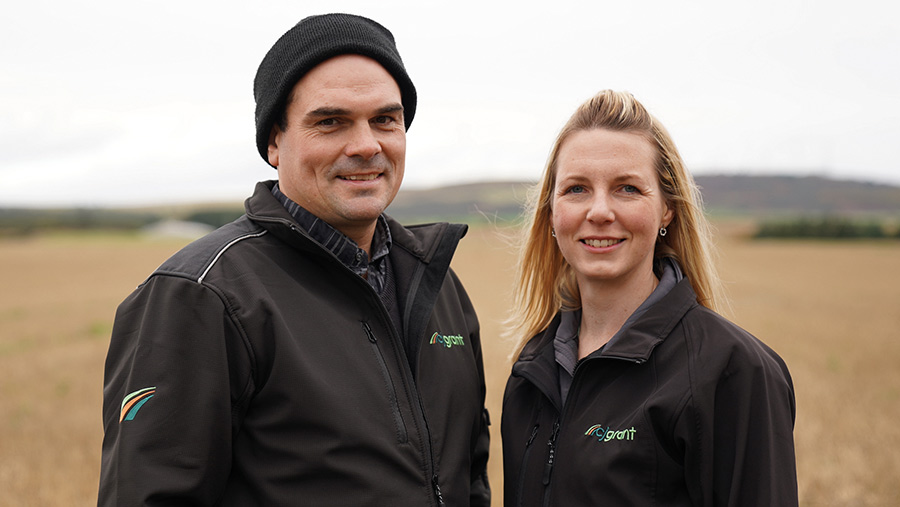
Craig and Claire Grant © Louise Impey
Further north, Craig – Farmers Weekly Young Farmer of the Year 2012 – and Claire Grant are running three separate farming businesses which include combinable crops, laying hens, beef cattle and pig enterprises, as well as some contracting work.
Their current emphasis is on reducing feed costs and their carbon footprint, as they keep moving forward.
The eventual plan is to use the Leaf Marque Standard scheme to show how they are producing good food from an integrated system in an environmentally responsible way.
CJ Grant: Key Actions
- Reducing fuel and fertiliser use
- Growing 50% of protein needed for chickens locally
- Producing healthy, quality food using the Leaf Marque Standard
Short term
The farm’s immediate priority is to improve efficiency and reduce inputs wherever possible.
With 160,000 laying hens across four sites, 200 head of cattle, finishing pigs and combinable crops, the couple are concentrating on doing the day-to-day basics right.
Some 25t of feed is used every day, so they are looking at how they can grow more of that themselves, make better use of local suppliers and reduce the amount of fuel required.
Grassland is already allowing them to make maximum use of manures, with only 6t of bagged fertiliser required this year to cover all their grazing and silage requirements.
“Muck is a commodity and we are intent on getting the most from it, especially at current fertiliser prices,” says Mr Grant, who hopes to reduce his fertiliser bill by a further 25%.
Chicken litter from the eight poultry sheds is tested three times a year and sold for 50% of its nutrient value to local farms, with much of the spreading done by CJ Grant.
Covered muck stores, built with grant funding, allow the product to be stored until ground conditions are suitable. “The aim is that the muck we sell finances our farm’s fertiliser requirements,” he explains.
Medium term
In the next five years, they are hoping to source 50% of the protein needed for the chickens from local sources, partially replacing the soya in the ration that comes from South America.
For that purpose, Mr Grant grew his first crop of spring beans this year and hopes future inclusion will allow him to widen the rotation and grow oilseed rape less frequently.
Having managed to harvest almost 5t/ha of beans, their 25% protein content meant that it cost him £3/percent of protein, considerably less than the £8 figure of imported soya.
He now wants to grow more and buy beans from local farmers, so that he can use 1,000t of beans annually in his rations. “At £220/t, that won’t necessarily be cheaper than soya, but it will give us a better carbon footprint,” he explains.
Beans also have an inherent fertility benefit for the following wheat crop, which will further reduce the need for fertiliser, he adds.
The couple will have to monitor the performance of hens and eggs on the new bean diet, but this is something they are already used to doing.
A split feeding regime – with the birds getting a different diet in the morning and the evening – has resulted in a 20% cost saving, but given better egg production and bird longevity.
Long term
Looking to the future, the couple are keen to leave the right legacy and have already paved the way by interacting with the local community and exceeding customer expectations.
An egg vending machine, located in an Egg Housie at the end of the farm drive, is popular with locals and their brand of Aberdeenshire Eggs is sold in 17 Tesco stores in Aberdeenshire.
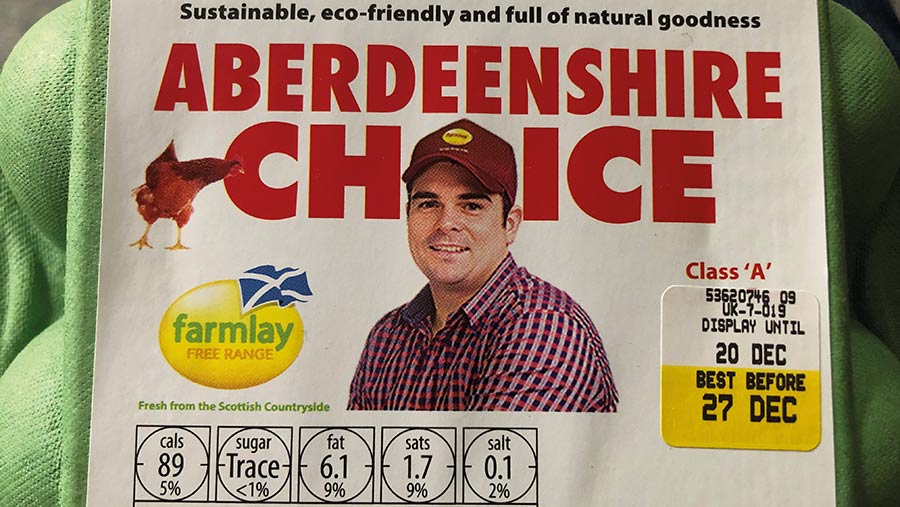
© Louise Impey
Grant funding to put in a path to an ancient stone circle has resulted in a well-used public access route from the village, with plans to introduce flowering strips and other biodiversity measures along the way.
Carbon footprinting work will continue, with the business using Eggbase as their preferred platform to share how the flocks are performing and the effect of the split feeding regime on reducing emissions and lowering their carbon footprint.
With two young sons, succession planning is also on the agenda, with the aim of consolidating their business and paying off any loans, while still taking advantage of any land-purchasing opportunities.
What is the Leaf/Corteva Resilient and Ready programme?
Linking Environment and Farming (Leaf) and Corteva Agriscience are working with four businesses to adopt more sustainable farming and gain the skills and know-how.
The four farms – two in Scotland and two in England – will undergo a tailored programme of training, consultancy and trials, measuring their performance and sharing their experiences with other farmers across the UK.

